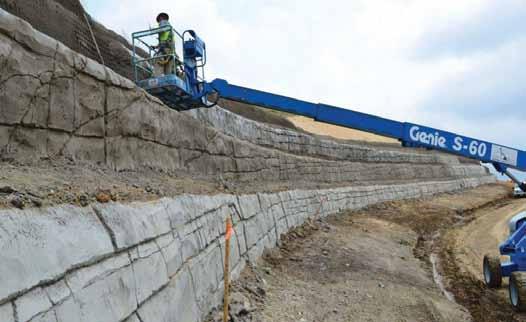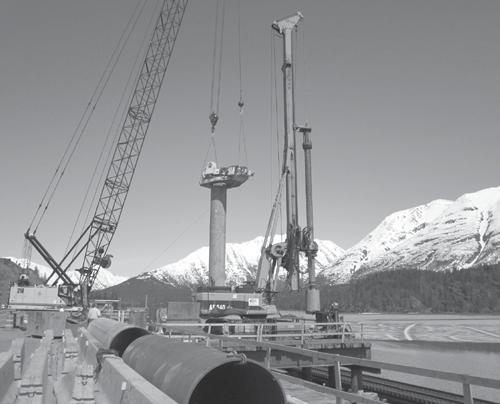
7 minute read
Construction Issues
Soil nail wall construction.
discussion of construction issues and techniques
When a line is drawn on paper, what does it mean? Retaining walls are usually drafted as a simple line on plans by the architect or engineer, with little direction other than a note: “Retaining wall design and construction by others.” But retaining walls are more than just a simple line. A range of decisions face the design and construction team when planning solutions for grade separations with a retaining wall. Understanding these decisions and accurately communicating them to the client, as well as to each other, is essential for engineers, particularly as the use of retaining walls in construction continues to grow. As usable or “good” sites become scarcer, retaining walls are often the only option for optimizing tight sites with hard-to-meet space requirements or significant slopes. In short, that simple line can make or break a project. The key to designing and constructing a successful retaining wall – and avoiding a “situation” – is careful consideration in the initial design phases, including (1) the type of system to use, and (2) the contractual approach to design and construction.
Type of System
Engineers have several different options for the design and construction of retaining walls. At present, retaining walls can be built out of traditional materials such as concrete and steel reinforcement, or from new technological materials such as geosynthetics and lightweight concrete. Furthermore, in the last twenty years, pre-manufactured retaining wall systems have become available that offer reasonable factors of safety while providing multiple aesthetic facing options. Typically, several conditions from the geotechnical, structural, civil, and construction perspectives have a bearing on the type of wall that is best suited for a particular site. Choosing the wrong type of wall may The Complexities of not provide sufficient restraint, may be impractical to construct, a Simple Line and may cause instability in the existing geotechnical conditions. A decision has to be made at the beginning of Considerations for design: Is the site better suited for top-down construction or bottom-up construction? Top- Retaining Wall Projects down construction is appropriate for sites that need to be excavated to achieve final grade, By John H. Hart, P.E., D.GE. while the bottom-up approach applies to sites that need to be filled. Technologies for topdown construction include soil nail walls, secant drilled shafts, and soldier pile walls, while technologies for bottom-up construction include mechanically stabilized earth (MSE) walls, conventional gravity walls, and gabion walls. Each of these technologies has unique applications that are dependent on the site layout, the height of wall, soil conditions, the presence of nearby structures, underground utilities, and the intended use of the areas near the top and bottom of the wall. Too often, the wrong wall type is selected for a site, which results in two retaining walls John H. Hart, P.E., D.GE. (JHart@ctlthompson.com), is a practicing engineer at CTL|Thompson in Denver, Colorado. Specializing in the fields of deep foundations, earth retention design, and landslide/ stability analysis, Hart has led a broad spectrum of projects. being constructed where only one is needed. An example is when a design incorporates a bottom-up wall that requires excavation into an existing slope. In order to provide the restraint required, such as a heel for concrete walls or geosynthetic length for MSE walls, a nearly vertical slope must be excavated behind these elements. This requires an additional top-down construction wall behind the proposed wall. If the designer is aware of all the retaining wall technologies, one top-down wall could be utilized in this situation, resulting in a substantial decrease in cost to the owner. continued on next page
Contractual Approach to Design
Top-down or bottom-up retaining walls have advantages and disadvantages that are specifi c to the site and situation. But who or what determines which retaining wall system is the most appropriate, considering cost, resistance and constructability? Th ere are generally two approaches to design and construction: the traditional approach, where an engineer designs the system and the contractor builds it; and the performancespecifi ed approach, where the engineer provides the basic criteria such as length, height, and location, and the contractor designs and builds the wall with engineering support, either in-house or subcontracted. Traditional Design Approach In the traditional approach, the contractor constructs the wall in accordance with the plans and specifi cations developed by the engineer. Th e owner hires an engineer to design a retaining wall, and the engineer provides plans and specifi cations for contractors to use in preparing competitive bids. If the features at the site and limitations of construction equipment are not fully understood, the proposed construction may not be achievable. In addition, if an engineer is well-versed in only one engineering discipline, then aspects from other points of view may be overlooked. Undeveloped properties may have unique slopes or geotechnical issues that are yet undiscovered. Th is can lead to a diffi cult situation – especially if it is the contractor that recognizes the problem once the team is in the fi eld. Soil conditions may not be uniform, slopes may be steeper than expected, or the design may not be adequate for the overall loads. If the contractor must make these decisions in the fi eld, it may lead to change orders, which in turn lead to extra costs for the owner. Furthermore, if the designer is not in the fi eld with the wall builder, there may be less communication, which sets up the engineer as an adversary and lessens the likelihood for success. Lastly, the wall built by the low bidder may not be the most aesthetically pleasing. On the other hand, there are real benefi ts to be derived from the traditional approach. For one thing, all of the contractors are bidding on the same design, which the engineer presumably designed in full compliance with the governing codes. Th is results in economical construction because it is streamlined and consistent – if the designer understands all engineering aspects of the retaining wall. It also puts the contractors in competition from a bidding perspective. In

Design/Build Earth Retention Foundation Support Slope Stabilization Ground Improvement Dewatering
800-562-8460 WWW.DBMCONTRACTORS.COM Donald B. Murphy Contractors, Inc. addition, the owner should be assured that a functioning fi nal product will be produced. Performance-Specifi ed Design Approach Another option for designing and building a retaining structure is the performancespecifi ed wall. In this approach, the design team provides basic criteria, such as desired wall length, height, etc. and the contractor, with engineering support, designs and builds the wall. In this scenario, an in-house engineer or engineering consultant subcontracted to the contractor designs the wall considering the basic criteria provided by the design team. Th e contractor’s engineer decides which specifi c system should be constructed and designs that system accordingly. Furthermore, the contractor’s engineer selects facing for the proposed wall, which may be block, something that matches the natural environment, or sculptured shotcrete, which looks like natural rock. Th ere are several advantages to this approach: It could result in a lower cost to the owner because it allows the engineering to be more innovative, enabling the designer to be more aggressive, potentially off ering more expertise as it relates to specifi c conditions and wall types. Th is approach also lays the groundwork for better communication between the engineer and contractor, so modifi cations can be made on the fl y.
Th ere are drawbacks as well. Th e performance of the wall may suff er because quality control and quality assurance is left in the contractor’s hands from both a design and construction perspective. Furthermore, the design may only be able to incorporate wall systems that the contractor can build and not truly evaluate diff erent wall systems that may be appropriate for the site.
An example would be when the engineer who is working for the contractor designs an MSE wall to be built by an MSE wall contractor; a soil nail wall system might have been more appropriate for the site, but the contractor does not have the equipment to build it. Finally, with innovation in design, codes may be pushed to the farthest extent, which may result in defi ciency in overall long-term performance of the wall.
Conclusion
Th ere are numerous approaches to design and many types of retaining systems, each with specialized applications that can be used to retain soil and/or provide stability to slopes. Understanding what is involved in each design approach, how the system is constructed, and under what conditions they are constructed is imperative to successful and economical design and construction.▪





